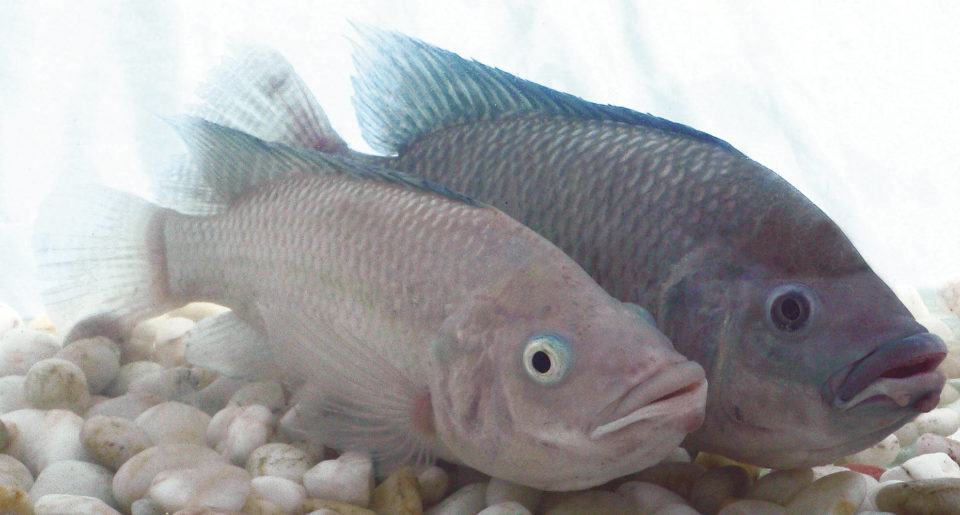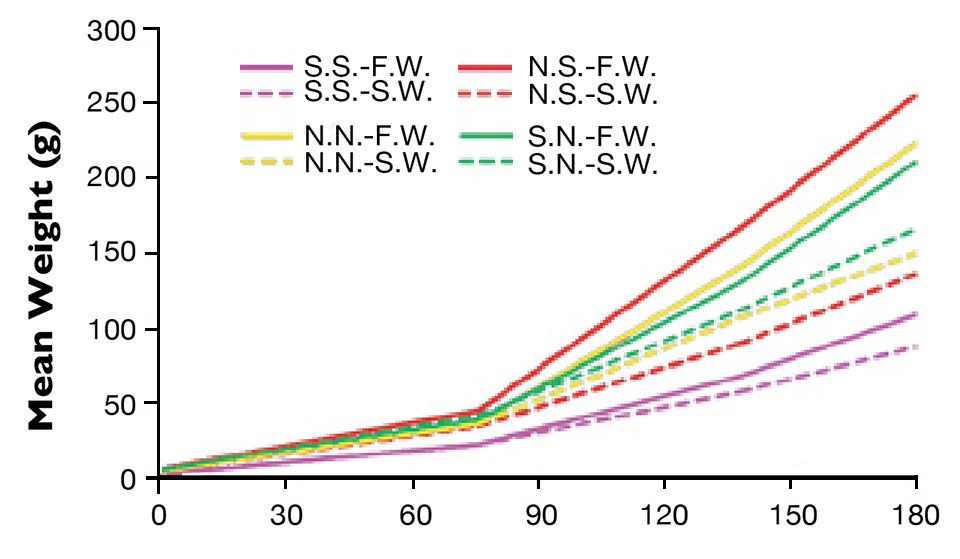Hybrids showed positive heterosis for body weight, growth and survival

There is an increasing interest in many coastal areas of the world, particularly arid regions, to culture tilapia in marine habitats. Therefore, producers must obtain hybrid tilapia capable of surviving and growing well in seawater culture facilities.
Most commercially cultured tilapia species, such as the Nile tilapia, Oreochromis niloticus, are suitable for production in freshwater and low-salinity waters only. However, the euryhaline Tilapia zillii; the biparental tilapia, Sarotherodon melanotheron; the maternal mouth brooders O. mossambicus and O. spilurus; and hybrids such as Florida red tilapia, O. urolepis hornorum x O. mossambicus; and the O. mossambicus x O. niloticus hybrids tolerate a wide range of salinities, and can thrive and reproduce successfully in full-strength seawater after proper acclimation. Moreover, crossing the high-salinity-tolerant O. mossambicus with the fast-growing red tilapia resulted in a hybrid in which desirable traits from the two species were combined.
Kuwait study
Kuwait is an arid country with a very limited amount of low-salinity underground water, but abundant seawater. Therefore, tilapia culture in saline environments is among the several options to grow tilapia in Kuwait.
The author conducted a study with partial funding from the Kuwait Foundation for the Advancement of Sciences to compare the growth, survival and presence of skin lesions and eye cataracts in first-generation hybrids developed through hybridization between the fast-growing Genetically Improved Farmed Tilapia (GIFT) strain of O. niloticus and the salt-tolerant O. spilurus with those of the original pure parents in freshwater and in full-strength seawater. The study also investigated whether hybrid vigor in growth, feed conversion and survival was present in the reciprocal hybrids.
Study setup
The pure-bred fish used in the study were O. spilurus (S.S.) and GIFT O. niloticus (N.N.) with parents of the same species. The reciprocal hybrids were female GIFT O. niloticus x male O. spilurus (N.S.) and female O. spilurus x male GIFT O. niloticus (S.N.). Each fish genotype represented a treatment, and each treatment was triplicated in 0.3-m3 fiberglass tanks within a recirculating water system.
Fish with a mean weight of 3.5 g were stocked at a rate of 150/m3. Water temperature was maintained at 29.0 ± 2.0 degrees C throughout the 180-day study. The fish were fed 47 percent-protein commercial pellets for sea bream at 10 percent of body weight daily, decreased gradually to 3 percent as the fish grew.
Results
Results showed the N.N. genotype reared in freshwater had significantly higher values for mean body weight and growth rates, followed by the N.S. and S.N. hybrids. The S.S. fish had the lowest values.
In seawater, the S.N. hybrid had the highest values for body weight and growth, followed by its reciprocal N.S. hybrid and the N.N. parents. However, no significant difference was observed among the S.N., N.S. and N.N. groups. The S.S. genotype had significantly lower values (Table 1). All fish groups in both salinities showed linear increases in body weight over time.
For both salinities, the feed-conversion ratios (FCRs) of the fish did not differ significantly among the four genotypes. However, the N.S. hybrid reared in freshwater and the S.N. hybrid reared in seawater had better FCRs than the pure-bred parents (Table 1). The increased FCR in seawater was presumably caused partly by the dilution of the digestive enzymes in the gut as a result of increased water intake by the fish to compensate for water loss through the gills during osmoregulation.
No significant difference was detected in survival among the four genotypes grown in freshwater (Table 1). The highest survival was observed in the S.N. hybrid. Survival in seawater, however, differed significantly among genotypes. The N.S. and S.N. hybrids had significantly higher survival than the parental N.N. and S.S. fish.
The better growth performance of the hybrids in seawater probably resulted from their greater osmoregulatory capacity than the N.N. parent, and the higher number and/or size of the chloride cells important in the seawater acclimation process in tilapia.
Ridha, Growth performance, Table 1
| Parameter | S.S. Group | N.N. Group | N.S. Group | S.N. Group |
|---|---|---|---|---|
| Freshwater* | ||||
| Mean body weight (g) | 108.20 ± 3.90c,x | 255.10 ± 14.90a,x | 222.70 ± 11.40ab,x | 203.9 ± 8.40b,x |
| Daily growth rate (g) | 0.58 ± 0.021c,x | 1.40 ± 0.083a,x | 1.22 ± 0.064ab,x | 1.11 ± 0.044b,x |
| Specific growth rate (%/day) | 1.90 ± 0.019c,x | 2.38 ± 0.033a,x | 2.30 ± 0.029ab,x | 2.26 ± 0.024b,x |
| Feed-conversion ratio | 1.48 ± 0.026a,y | 1.46 ± 0.036a,x | 1.42 ± 0.079a,x | 1.45 ± 0.036a,x |
| Survival (%) | 91.80 ± 1.47c,x | 91.10 ± 3.41a,x | 92.60 ± 4.52a,x | 96.3 ± 2.68a,x |
| Seawater | ||||
| Mean body weight (g) | 87.50 ± 8.70b,x | 135.50 ± 2.30a,y | 149.20 ± 5.10a,y | 165.90 ±17.60a,x |
| Daily growth rate (g) | 0.47 ± 0.049b,x | 0.73 ± 0.012a,y | 0.81 ± 0.026a,y | 0.90 ± 0.099a,x |
| Specific growth rate (%/day) | 1.78 ± 0.055b,x | 2.03 ± 0.012a,y | 2.09 ± 0.018a,y | 2.14 ± 0.061a,x |
| Feed-conversion ratio | 1.70 ± 0.033a,x | 1.69 ± 0.134a,x | 1.63 ± 0.74a,x | 1.53 ± 0.018a,x |
| Survival (%) | 74.80 ± 3.20b,y | 79.30 ± 1.94b,y | 91.90 ± 1.97a,x | 96.30 ± 0.73a,x |
| Skin lesions (%) | 0b | 19.0 ± 6.70a | 0b | 1.60 ± 1.60b |
| Fin and tail rot (%) | 0b | 34.40 ± 11.60a | 0b | 0.77 ± 0.80b |
| Eye cataracts (%) | 0b | 3.80 ± 1.10a | 4.90 ± 0.90a | 3.90 ±1.60a |
Superscripts a, b and c denote horizontal comparison within a row, while superscripts x and y are for vertical comparison. Different superscripts are significantly different (P < 0.05).
Table 1. Growth performance of hybrid tilapia and their pure-bred parents.
Deformities
No incidence of skin lesions, tail and fin rot, or eye cataract was observed in the four genotypes reared in freshwater (Table 1). However, the pure-bred N.N. genotype reared in seawater had significantly higher rates of skin lesions and rot than the other genotypes. No incidence of lesions and rot was observed in the S.S. fish and the N.S. hybrids, whereas the S.N. hybrids had low rates for the conditions.
The incidence of eye cataracts in the N.N., N.S. and S.N. fish was low and did not differ significantly among the three genotypes (Table 1). These results also reflected the better salinity tolerance of the hybrids and confirmed the lower tolerance and limited adaptability of the Nile tilapia to high salinity levels. Sexual dimorphism was evident in the four genotypes reared in either salinity. Males were significantly bigger than the females.
Salinity, genotype
Analysis showed that weight, growth and survival were significantly affected by salinity and by genotype, with an interaction between salinity and genotype. However, FCR was only affected by salinity.
Irrespective of genotype, fish reared in freshwater had significantly higher body weight, daily growth, specific growth rates and survival, and lower FCR compared with fish reared in seawater. On the other hand, regardless of salinity, the S.S. pure-bred parents had lower weights and growth than the other genotypes. The reciprocal hybrids N.S. and S.N. had significantly higher survival than their S.S. and N.N. parents.

Hybrid vigor
In freshwater and seawater, pooled data for the hybrids showed positive heterosis for body weight, growth and survival (Table 2). The values indicated hybrid vigor was produced, and a combination of the fast-growth trait from the GIFT Nile tilapia parent and the salinity tolerance from the O. spilurus parent yielded better growth outcomes.
No heterotic effect was obtained for FCR in either salinity (Table 2). In freshwater, the N.S. hybrids had slightly higher heterotic values for mean body weight and daily growth rate than the S.N. hybrids, whereas in seawater, the S.N. hybrids had higher heterosis for weight and growth than the N.S. fish. In general, hybrids reared in seawater had higher heterosis than those reared in freshwater.
Ridha, Heterosis for performance, Table 2
| Parameter | Both Hybrids | N.S. Group | S.N. Group |
|---|---|---|---|
| Freshwater | |||
| Mean body weight (g) | 17.40 | 1.23 | 1.12 |
| Daily growth rate (g) | 17.80 | 1.23 | 1.12 |
| Specific growth rate (%/day) | 6.50 | 1.08 | 1.05 |
| Feed-conversion ratio | -2.20 | 0.97 | 0.99 |
| Survival (%) | 3.20 | 1.01 | 1.05 |
| Seawater | |||
| Mean body weight (g) | 41.30 | 1.34 | 1.49 |
| Daily growth rate (g) | 42.50 | 1.35 | 1.50 |
| Specific growth rate (%/day) | 10.70 | 1.09 | 1.12 |
| Feed-conversion ratio | -6.80 | 0.96 | 0.90 |
| Survival (%) | 22.10 | 1.19 | 1.25 |
(Editor’s Note: This article was originally published in the January/February 2015 print edition of the Global Aquaculture Advocate.)
Author
-
Mohammad T. Ridha
Environment and Life Sciences Research Center
Kuwait Institute for Scientific Research
P. O. Box 1638
22017 Salmiyah, Kuwait[109,111,99,46,108,105,97,109,103,64,53,53,49,48,49,97,104,100,105,114,109]
Tagged With
Related Posts

Intelligence
Adding value to tilapia to tap into U.S. market
New markets for tilapia and expansion of existing ones can be created by planning and implementing properly designed geographic strategies to meet discriminating consumer preferences. Low labor costs in most producing countries promotes value-adding by the production of fresh fillets.

Responsibility
Addressing safety in Latin America’s tilapia supply chain
Over the last decade, the experience gained by many tilapia farmers combined with proficient programs implemented by local governments have significantly improved tilapia production in various Latin American countries like Colombia, Mexico, Ecuador and other important tilapia producers in the region.

Health & Welfare
Applied commercial breeding program for Nile tilapia in Egypt
A major goal of selective breeding program for Nile tilapia (Oreochromis niloticus) in Egypt is to select for fillet color and fillet weight in response to consumer preferences.

Responsibility
Calcium and magnesium use in aquaculture
Aquatic plants and animals get the essential nutrients calcium and magnesium from water and food. Calcium concentrations impact the hydration and development of eggs in a hatchery, where calcium carbonate precipitation can be troublesome.


